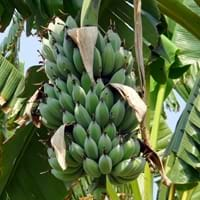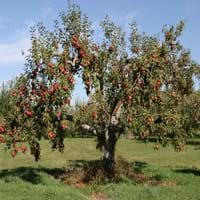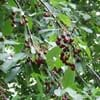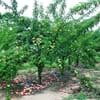Life Span
Perennial
Perennial
Origin
Hybrid origin
Eastern Europe, Southern Europe, Russia/Siberia, Southern Asia, Western Asia
Types
Not Available
Not avaialable
Number of Varieties
Not Available
Habitat
Humid climates, Tropical regions
Hillside, Mountain Slopes, Temperate Regions
USDA Hardiness Zone
9-15
5-8
Sunset Zone
H1, H2, 21, 22, 23, 24
2a, 2b, 3a, 3b, 7
Habit
Clump-Forming
Oval or Rounded
Flower Color
White, Light Yellow
White, Pink
Flower Color Modifier
Bicolor
Bicolor
Fruit Color
Yellow, Green, Gold
Red
Leaf Color in Spring
Green
Green
Leaf Color in Summer
Green
Green
Leaf Color in Fall
Green
Green
Leaf Color in Winter
Light Green
Light Green
Plant Season
Spring, Summer, Fall, Winter
Spring, Fall
Sunlight
Full Sun, Partial Sun
Full Sun, Partial Sun, Partial shade
Growth Rate
Very Fast
Medium
Type of Soil
Loam, Sand
Clay, Loam
The pH of Soil
Acidic, Neutral
Acidic, Neutral
Soil Drainage
Well drained
Well drained
Bloom Time
Indeterminate
Early Spring, Spring
Tolerances
Drought
Drought
Where to Plant?
Container, Ground, Pot
Ground
How to Plant?
Cuttings, Divison, Tissue culture
Grafting, Seedlings, Transplanting
Plant Maintenance
Medium
Medium
Watering Requirements
Average Water Needs
Medium
In Summer
Lots of watering
Lots of watering
In Spring
Moderate
Moderate
In Winter
Average Water
Average Water
Soil pH
Acidic, Neutral
Acidic, Neutral
Soil Type
Loam, Sand
Clay, Loam
Soil Drainage Capacity
Well drained
Well drained
Sun Exposure
Full Sun, Partial Sun
Full Sun, Partial Sun, Partial shade
Pruning
Remove damaged leaves, Remove dead branches, Remove dead leaves
Remove damaged leaves, Remove dead branches, Remove dead leaves
Fertilizers
All-Purpose Liquid Fertilizer
All-Purpose Liquid Fertilizer
Pests and Diseases
Banana aphid, Banana mosaic, Banana weevil
Black rot, Leaf spot, Scab
Plant Tolerance
Drought
Drought
Flower Petal Number
Single
Single
Foliage Texture
Bold
Medium
Foliage Sheen
Matte
Matte
Attracts
Hummingbirds, Small mammals
Birds
Allergy
Nausea
Mouth itching, Throat itching
Aesthetic Uses
Showy Purposes
Not Used For Aesthetic Purpose
Beauty Benefits
Not Available
Not Available
Environmental Uses
Air purification
Air purification
Medicinal Uses
Nutrients
Cancer, constipation, Diabetes, Diarrhea, Dysentry, Fever, Heart problems, Tooth ache
Part of Plant Used
Flowers, Leaves
Fruits
Other Uses
Used As Food
Used As Food, Wood is used for making furniture
Used As Indoor Plant
No
No
Used As Outdoor Plant
Yes
Yes
Garden Design
Edible, Feature Plant, Fruit / Fruit Tree, Mixed Border, Tropical
Edible, Feature Plant, Fruit / Fruit Tree, Topiary / Bonsai / Espalier
Botanical Name
Musa acuminata
MALUS domestica 'Red Delicious'
Common Name
Banana, Cavendish Banana
Apple, Red Delicious Apple, Red Eating Apple
In Hindi
Cavendish Banana
लाल स्वादिष्ट सेब
In German
Cavendish Banana
Red Delicious
In French
Cavendish Banana
Red Delicious
In Spanish
Cavendish Banana
Manzana Red Delicious
In Greek
Cavendish Banana
Red Delicious μήλο
In Portuguese
Cavendish Banana
Red Delicious apple
In Polish
Cavendish Banana
Red Delicious jabłko
In Latin
Cavendish Banana
Red Delicious apple
Phylum
Magnoliophyta
Magnoliophyta
Class
Liliopsida
Magnoliopsida
Order
Zingiberales
Rosales
Clade
Angiosperms, Commelinids, Monocots
Angiosperms, Eudicots, Rosids
Tribe
Not Available
Not Available
Subfamily
Not Available
Not Available
Number of Species
Not Available
Properties of Cavendish Banana and Red Delicious Apple
Wondering what are the properties of Cavendish Banana and Red Delicious Apple? We provide you with everything About Cavendish Banana and Red Delicious Apple. Cavendish Banana has thorns and Red Delicious Apple doesn't have thorns. Also Cavendish Banana does not have fragrant flowers. Cavendish Banana has allergic reactions like Nausea and Red Delicious Apple has allergic reactions like Nausea. Compare all the properties and characteristics of these two plants. Find out which of these plant can be used as indoor plant. If you are interested to decorate your house and garden, find out aesthetic uses, compare them and select the plant which will beautify your surrounding. Along with beautification, try comparing medicinal and edible uses of Cavendish Banana and Red Delicious Apple and you can choose the plant having best and most benefits.
Season and Care of Cavendish Banana and Red Delicious Apple
Season and care of Cavendish Banana and Red Delicious Apple is important to know. While considering everything about Cavendish Banana and Red Delicious Apple Care, growing season is an essential factor. Cavendish Banana season is Spring, Summer, Fall and Winter and Red Delicious Apple season is Spring, Summer, Fall and Winter. The type of soil for Cavendish Banana is Loam, Sand and for Red Delicious Apple is Clay, Loam while the PH of soil for Cavendish Banana is Acidic, Neutral and for Red Delicious Apple is Acidic, Neutral.
Cavendish Banana and Red Delicious Apple Physical Information
Cavendish Banana and Red Delicious Apple physical information is very important for comparison. Cavendish Banana height is 90.00 cm and width 60.00 cm whereas Red Delicious Apple height is 460.00 cm and width 460.00 cm. The color specification of Cavendish Banana and Red Delicious Apple are as follows:
Cavendish Banana flower color: White and Light Yellow
Cavendish Banana leaf color: Green
Red Delicious Apple flower color: White and Pink
- Red Delicious Apple leaf color: Green
Care of Cavendish Banana and Red Delicious Apple
Care of Cavendish Banana and Red Delicious Apple include pruning, fertilizers, watering etc. Cavendish Banana pruning is done Remove damaged leaves, Remove dead branches and Remove dead leaves and Red Delicious Apple pruning is done Remove damaged leaves, Remove dead branches and Remove dead leaves. In summer Cavendish Banana needs Lots of watering and in winter, it needs Average Water. Whereas, in summer Red Delicious Apple needs Lots of watering and in winter, it needs Average Water.





